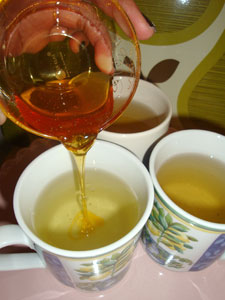The Buzz On Honey

Honey has been a favorite food staple throughout history, with appearances in ancient texts as a sweetener of cakes and other foods, a form of currency, and a type of medicine. As a sweetener, it found itself in cups of tea standing alongside sugar as a favorite sweetener to the popular beverage. Though this practice may be frowned upon by purists, it can be a delightful addition and add great nuances to an already flavorful cup of tea. There are many varieties of honey being produced, all with their unique flavor.
This golden syrup is produced by bees, from nectar collected by these busy creatures from different flowers. The type of flowers they collect the nectar from will effect the flavor of the honey; with many local producers popping up all over the world (beekeeping is becoming a popular hobby!) there is almost an infinite variety of flavors out there due to the local flowers specific to an area. With the help of the HoneyLocator.com you can see what local honey offerings are in your area.
A favorite honey company of ours, Tropical Blossom Honey Co, based in Florida allowed us to taste a selection of their most popular flavors of honey. The honeys that we tasted were:
- Orange Blossom: Delicate, waxy, with floral and citrus notes.
- Palmetto: Originates from the Saw Palmetto plant, a shrubby palm that grows throughout Florida. Bright and golden, with an extra sweet fragrance, and is used also in baking and desserts.
- Galberry: Originates from the the Gallberry/Inkberry shrub, which is part of the Holly family and grows throughout Florida. A tart honey with a hint of berries and sweetness.
- Tupelo Honey: One of the most rarest honeys in the world, it is a light colored syrup. It naturally contains a higher amount of fructose, so you can use half as much when sweetening your tea or food.
All the honey varieties were good on their own (talk about craving some fresh scones with honey and cream!) but obviously we wanted to try them out with some of our teas to see what pairings we could come up with. Our favorites below:
- Galberry Honey with Green Anji: The subtle flavor of the Green Anji was still apparent with the addition of a 1/2 tsp of this flavor of honey. The berry note in the honey added a nice fruitiness to the cup.
- Orange Blossom Honey with Honeybush: Given honeybush tea's natural sweetness, this was an obvious pairing. The citrus in the honey made itself apparent when mixed with this tea. We could imagine also pairing Orange Blossom Honey with any of the flavored Honeybush teas, as well as Rooibos and our flavored Rooibos teas.
- Orange Blossom Honey with Jasmine #12/Dragon Pearls: Jasmine tea alone is already rich with an intoxicating scent and taste, but the Orange Blossom honey melded with it quite nicely. Fragrant and floral all around!
- Tupelo Honey with White Peony: This was my favorite pairing. White Peony is my favorite white tea, because of the natural citrus notes in the flavor. The tupelo honey gives the lighter tea a good body without being overtly sweet.
Some useful honey tips and facts:
- Crystallization can occur with honey. This is not an indicator of spoiling or staleness, but rather a natural occurrence in which the glucose in honey suddenly changes state and forms crystals. Just soak your container of honey in another bowl or glass of warm water- this will break up the crystals.
- Looking for an expiration date on your bottle of honey- guess what? It never goes bad. You can keep honey for eternity!
- The leading countries in honey production are China, United States, Turkey, and Mexico.
- There are two types of honey, depending on the number of flowers the bees collect pollen from- polyfloral (when bees collect from various fauna) and monofloral (when bees collect from a specific flower). The latter can be thought of as 'single-origin' honey- the varieties mentioned in this article can be considered monofloral.
- Micro organisms cannot grown in honey; this explains its long shelf life and the fact that you can keep it at room temperature or in your pantry. This is because of the low water content in honey. However, honey frequently contains a particular dormant endospore that can form a particular bacteria (Clostridium botulinum). This bacteria can form toxins that an infant's digestive tract cannot handle- this is why you should not feed honey to anyone under the age of one.
- There are four types of honeybees: The Little Honeybee (Apis florea), The Eastern Honeybee(Apis cerana), The Giant Honeybee(Apis dorsata), and The Western Honeybee (Apis mellifera)
Try out varieties honey with your favorite teas to see what you like. I suggest using just a little bit at a time- you don't want to go overboard, especially with a honey like Tupelo, so keep your hand steady and try 1/4-1/2 tsp per cup. Increase as desired and enjoy!
Please visit Tropical Blossom Honey for more information and to purchase the honey mentioned in this article.
